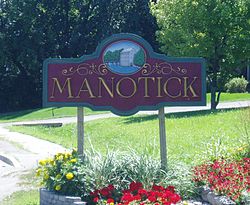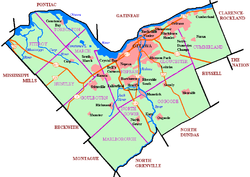Manotick
| Manotick | |
|---|---|
| Community | |
 |
|
| Location in Ottawa | |
| Coordinates: 45°13′35″N 75°41′11″W / 45.22639°N 75.68639°W | |
| Country | Canada |
| Province | Ontario |
| City | Ottawa |
| Established | 1830s |
| Incorporated | 1903 (Police Village of Manotick) |
| Amalgamation | 1974 (Township of Rideau) 2001 (City of Ottawa) |
| Government | |
| • Mayor | Jim Watson |
| • MPs | Pierre Poilievre |
| • MPPs | Lisa MacLeod |
| • Councillors | Scott Moffatt |
| Area | |
| • Total | 6.70 km2 (2.59 sq mi) |
| Elevation | 95 m (312 ft) |
| Population (2016) | |
| • Total | 4,486 |
| • Density | 669.4/km2 (1,734/sq mi) |
| Canada 2016 Census | |
| Time zone | Eastern (EST) (UTC−5) |
| • Summer (DST) | EDT (UTC−4) |
Manotick is a community in Rideau-Goulbourn Ward in the rural south part of the City of Ottawa, Ontario, Canada. It is a suburb of the city, located on the Rideau River, immediately south of the suburbs Barrhaven and Riverside South, about 25 km (16 mi) from downtown Ottawa. It was founded by Moss Kent Dickinson in 1864. He named the village 'Manotick', after the Algonquin word for 'island'. It has been part of the City of Ottawa since amalgamation in 2001. Prior to that, it was located in Rideau Township. According to the Canada 2016 Census, Manotick had a population of 4,486.
The village of Long Island Locks was first settled in 1833. In the 1830s, a small settlement formed in the area of the newly constructed Long Island locks on the Rideau Canal, but there was no development in the area of present-day Manotick. A post office was established in 1854.
In 1859, when a bulkhead was constructed across the west branch of the Rideau River, entrepreneur Moss Kent Dickinson and his partner Joseph Merrill Currier obtained the water rights and constructed a stone mill, on the shores of the Rideau River. The flour mill, as well as a carding mill, sawmill and a bung factory, also built by Dickinson, helped spur the development of the settlement. The flour mill was purchased in 1946 by Harry Watson and renamed Watson's Mill. It survives today as a working museum with an operational grist mill.
M. K. Dickinson, Esq., established the Long Island Flouring Mills in 1860, which had the capacity of grinding one hundred barrels of flour per diem; the buildings were substantially built of stone. The saw mill, built by M. K. Dickinson, Esq., employed twelve men, and turned out about two million feet of sawn lumber per annum.
...
Wikipedia

